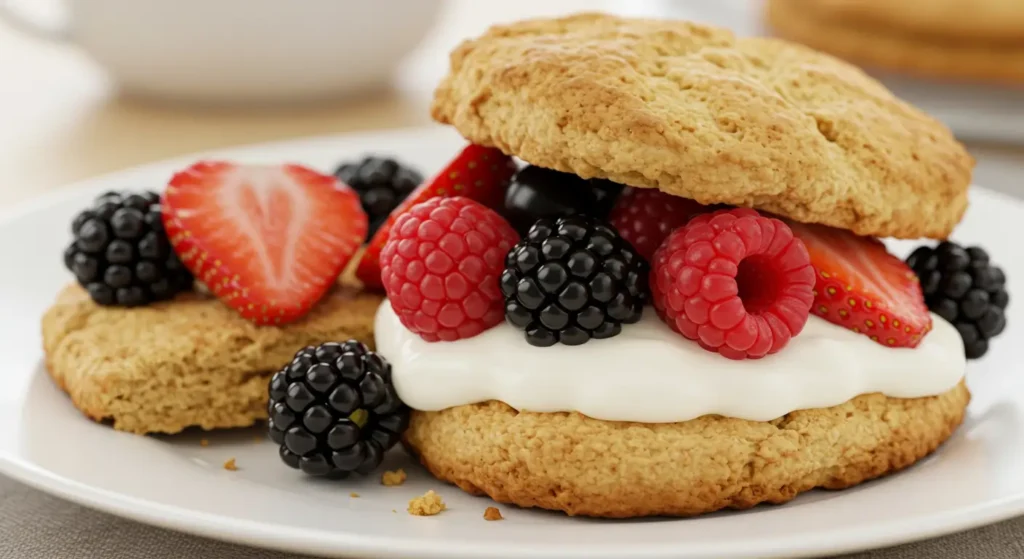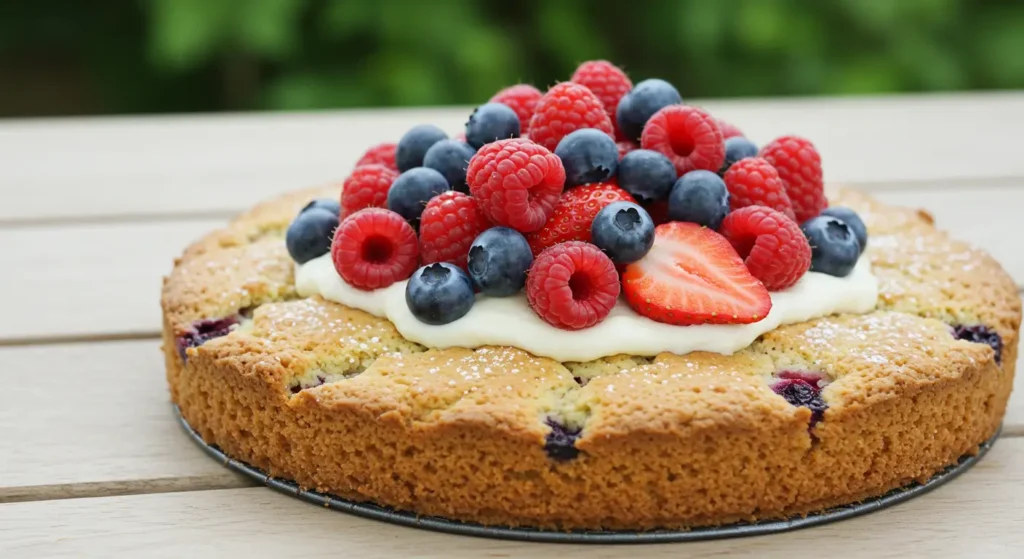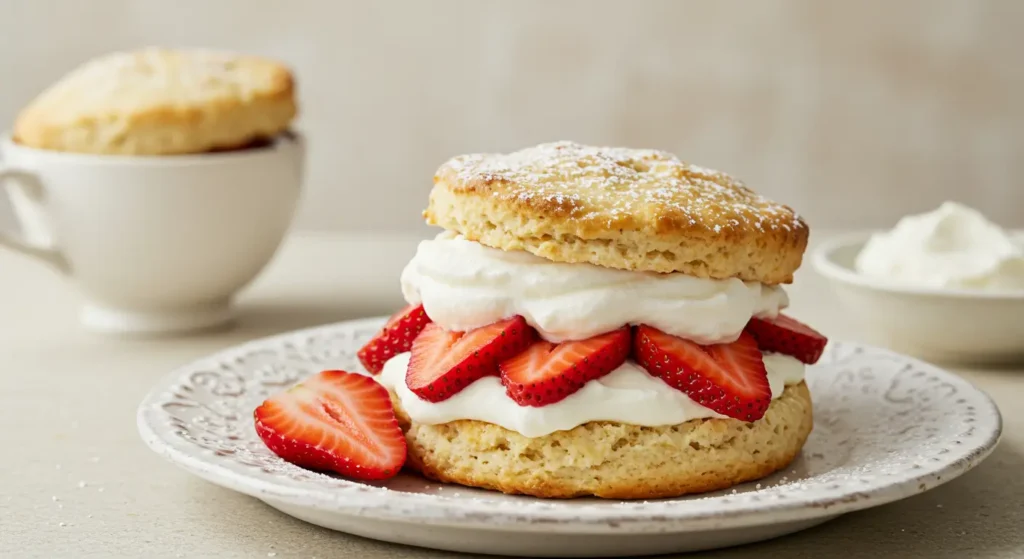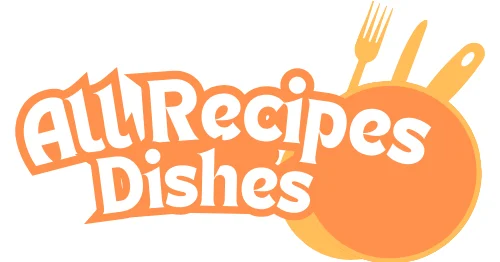Discover the Best Gluten-Free Shortcake
Table of Contents
If you have gluten intolerance or sensitivity, finding tasty desserts can be hard. Traditional shortcake recipes often have gluten, which is a problem for those who can’t eat it.
But, with the right gluten-free baking methods and ingredients, you can enjoy a delicious shortcake. It’s just as good as the traditional kind.
Finding a good shortcake recipe is key for those who can’t eat gluten. In this guide, we’ll dive into gluten-free shortcake. We’ll give you the tools and knowledge to make a dessert that’s both tasty and satisfying.
Key Takeaways
- Understanding the challenges of gluten-free baking for shortcake
- Learning the essential ingredients for a great gluten-free shortcake
- Discovering tips for achieving tender and delicious shortcake
- Exploring various gluten-free shortcake recipes
- Mastering the art of gluten-free baking for desserts
Understanding Shortcake and Gluten-Free Baking
To master gluten-free shortcake, you need to know traditional shortcake and gluten-free baking basics. Classic shortcake has been a cherished dessert for generations. Making it gluten-free means learning about both traditional baking and gluten-free ingredients.
What Makes a Traditional Shortcake
A traditional shortcake uses all-purpose flour, sugar, baking powder, and butter or cream. These ingredients mix to create a tender, crumbly texture. It’s often served with fruit and whipped cream.
Why Gluten-Free Baking Requires Different Approaches
Gluten-free baking is tricky because it lacks gluten, a protein in wheat. Gluten gives baked goods structure and elasticity. Gluten-free bakers use flour blends and xanthan gum to get a similar texture.
| Ingredient/Technique | Traditional Baking | Gluten-Free Baking |
|---|---|---|
| Flour | All-purpose flour | Blend of rice, almond, coconut flour, etc. |
| Binding Agent | Gluten | Xanthan gum, guar gum |
| Liquid Content | Standard liquid content | Often requires more liquid |
Health Benefits of Going Gluten-Free
Going gluten-free can improve digestion and reduce inflammation. This recipe is suitable for individuals with celiac disease or gluten sensitivity. It can also lead to better overall health.
Even without gluten intolerance, adopting a gluten-free diet can offer health benefits. It focuses on whole, nutrient-rich foods.
Understanding these points helps you face gluten-free baking challenges. You can then enjoy a delicious gluten-free shortcake.
Essential Ingredients for the Perfect Gluten-Free Shortcake
To make the perfect gluten-free shortcake, you need to know the key ingredients. You must pick the right parts to make your shortcake tasty and just right in texture.
Best Gluten-Free Flour Blends for Baking
Selecting an appropriate gluten-free flour blend is crucial for achieving the desired shortcake texture. You can use a pre-mixed blend or mix your own with flours like almond, coconut, or rice. A good mix balances structure and softness.

Some top gluten-free flours are:
- Almond flour for richness and flavor
- Coconut flour for its dryness and texture
- Rice flour for lightness and softness
| Flour Type | Characteristics | Best Use |
|---|---|---|
| Almond Flour | Rich, nutty flavor; dense texture | Cakes, cookies, and pastry crusts |
| Coconut Flour | Highly absorbent; can be dry | Baked goods that need extra liquid |
| Rice Flour | Light, delicate texture; neutral flavor | General baking, including shortcakes |
Key Binding Agents and Leaveners
Binding agents and leaveners are crucial in gluten-free baking. They replace gluten’s binding properties. Xanthan gum and guar gum are common binding agents. Baking powder and baking soda are leaveners.
Xanthan gum improves texture and structure. Guar gum adds elasticity and keeps moisture.
Sweeteners and Flavorings That Enhance Texture
Sweeteners and flavorings add taste and can change the shortcake’s texture. The right sweetener keeps it moist and tender.
Some good options are:
- Coconut sugar for a caramel flavor
- Honey for moisture and unique taste
- Vanilla extract for deeper flavor
By picking and mixing these ingredients carefully, you can make a gluten-free shortcake that’s both tasty and satisfying.
The Ultimate Gluten Free Shortcake Recipe
Making a gluten-free shortcake that rivals the traditional one requires the right ingredients and a tested recipe. You need to focus on ingredient preparation, mixing techniques, and baking methods. These steps are key to a perfect gluten-free shortcake.
Preparing Your Ingredients and Equipment
Before mixing, prepare all needed ingredients and equipment. This includes measuring out your gluten-free flour blend, cold butter, and other ingredients. Make sure your baking tools, like bowls and sheets, are clean and ready.
Some essential ingredients to prepare are:
- Gluten-free flour blend
- Cold unsalted butter
- Granulated sugar
- Eggs
- Heavy cream or buttermilk

Mixing the Dry Ingredients Properly
Properly mixing dry ingredients is key to creating a tender shortcake. In a large bowl, mix your gluten-free flour blend, sugar, baking powder, and salt. Whisk until well combined.
Key dry ingredients to mix are:
- Gluten-free flour blend
- Granulated sugar
- Baking powder
- Salt
Incorporating Wet Ingredients Without Overmixing
Once dry ingredients are mixed, add wet ingredients. This includes cold butter, eggs, and heavy cream or buttermilk. Utilize a pastry cutter or your hands to blend until the mixture resembles coarse crumbs.
To avoid overmixing, gently fold in wet ingredients until a dough forms. Be careful not to overwork it.
Baking Techniques for Perfect Texture
For optimal texture, ensure your oven is properly preheated and bake until the surface achieves a light golden hue. Use parchment paper on your baking sheet to prevent sticking.
Some baking tips include:
- Preheating your oven to the correct temperature
- Using a baking sheet lined with parchment paper
- Baking until the shortcakes are lightly golden
Cooling and Serving Your Shortcake
After baking, let your shortcakes cool on a wire rack. This helps keep their texture and prevents sogginess. Once cooled, split them in half and fill with your favorite fruits and whipped cream.

To serve, consider the following:
- Splitting the shortcakes in half horizontally
- Filling with fresh fruits and whipped cream
- Serving immediately to preserve texture and flavor
Delicious Variations and Serving Suggestions
Gluten-free shortcake is great because you can pair it with many fruits, creams, and desserts. It’s a blank canvas for your creativity. You can try different flavors and looks for any event or diet.
Seasonal Fruit Toppings and Pairings
Changing up your gluten-free shortcake is easy with seasonal fruits. In summer, try strawberries and whipped cream. In winter, poached pears or baked apples with cinnamon are perfect. The goal is to mix the shortcake’s sweetness with the fruit’s tartness.
Here’s a table of seasonal fruits and pairing ideas:
| Season | Fruit | Pairing Suggestion |
|---|---|---|
| Spring | Strawberries, Rhubarb | Whipped cream, vanilla ice cream |
| Summer | Blueberries, Peaches | Mint leaves, lemon zest |
| Autumn | Apples, Pears | Cinnamon, caramel sauce |
| Winter | Cranberries, Quince | Orange zest, almond cream |
Dairy-Free and Vegan Adaptations
If you can’t have dairy, there are great alternatives. Opt for coconut cream or almond milk-based desserts to create a dairy-free shortcake. Vegan chocolate sauce or fruit coulis add flavor.
Creative Shortcake Dessert Ideas
Don’t stick to the usual shortcake look. Crumble it and layer with fruit and cream in a parfait glass. Or, use it in a trifle with custard and fruit. Your creativity is the only limit.
Experimenting with various adaptations and presentation styles keeps gluten-free shortcake both interesting and delectable. It’s a fun dessert to play with.
Conclusion
You now have the tools to make a delicious gluten-free shortcake. It’s sure to impress anyone. By using the right ingredients and understanding gluten-free baking, you can make a tender and flavorful dessert.
The shortcake recipe we provided is a great place to start. You can try different gluten-free dessert ideas to make it your own. Pair it with seasonal fruits or make it dairy-free and vegan for different tastes and diets.
Delving into gluten-free baking offers an enjoyable and rewarding culinary experience. You’ll find joy in making treats that everyone can enjoy. So, get creative and enjoy the endless possibilities of gluten-free shortcake. Your taste buds will thank you.
FAQ
What is gluten-free shortcake?
Gluten-free shortcake is a dessert made with gluten-free flours. It’s for people with gluten intolerance or sensitivity. It tastes and feels like traditional shortcake.
Why is gluten-free baking challenging?
Gluten-free baking is hard because gluten-free flours don’t have gluten’s structure and binding. You need different ingredients and methods to get the right texture.
What are the best gluten-free flour blends for baking shortcake?
The top gluten-free flour blends for shortcake include rice flour, almond flour, coconut flour, and potato starch. They give a good texture and taste.
Can I make gluten-free shortcake dairy-free or vegan?
Yes, you can make gluten-free shortcake dairy-free or vegan. Use almond milk, coconut cream, or vegan butter instead of traditional dairy.
How do I store gluten-free shortcake to maintain freshness?
Preserve gluten-free shortcake by storing it in an airtight container at room temperature for up to two days. Or freeze it for longer, thawing as needed.
What are some creative ways to serve gluten-free shortcake?
Serve gluten-free shortcake with seasonal fruit, whipped cream, or dairy-free alternatives. Get creative with ideas like shortcake trifles or layered desserts.
Can I use a gluten-free shortcake recipe for other desserts?
Yes, you can adapt a gluten-free shortcake recipe for other desserts. Like gluten-free biscuits or scones, by changing ingredients and baking methods.
How do I achieve the perfect texture in gluten-free shortcake?
For the perfect texture, use the right gluten-free flour blend. Don’t overmix the batter. Follow proper baking techniques, like using the right leavening agents and not overbaking.

